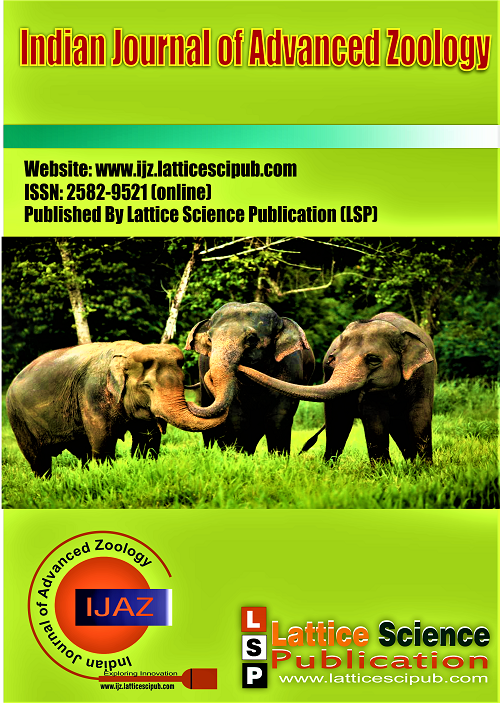Ants as a Model of Preparedness, Mitigation, and Recovery in Disaster Risk Reduction
Main Article Content
Abstract
Disaster Risk Reduction (DRR) necessitates systems that are proactive, flexible, and community-focused. Nature provides excellent examples of such systems, particularly the social behaviour of ants. This research examines how ants exemplify the four fundamental components of disaster risk reduction (DRR): mitigation, preparedness, response, and recovery. Ant colonies employ risk-reduction tactics, including structural planning, resource management, division of labour, and cooperative recovery, to exhibit effective and sustainable disaster management procedures. By researching ant behaviour using a catastrophe risk reduction paradigm, the paper provides valuable insights into how biomimicry might be integrated into human disaster preparedness and resilience.
Downloads
Article Details

This work is licensed under a Creative Commons Attribution-NonCommercial-NoDerivatives 4.0 International License.
How to Cite
References
Bonabeau, E., Dorigo, M., & Theraulaz, G. (2018). Swarm Intelligence: From Natural to Artificial Systems (Reprint). Oxford University Press. https://global.oup.com/academic/product/swarm-intelligence-9780195131581
Camazine, S., Deneubourg, J.-L., Franks, N. R., Sneyd, J., Theraulaz, G., & Bonabeau, E. (2017). Self-Organization in Biological Systems (2nd edition). Princeton University Press. DOI: https://doi.org/10.1515/9781400884208
Holldobler, B., & Wilson, E. O. (2020). The Superorganism: The Beauty, Elegance, and Strangeness of Insect Societies (Revised Edition). W. W. Norton & Company. https://wwnorton.com/books/9780393602876
Couzin, I. D., & Krause, J. (2021). Self-organisation and collective behaviour in biological systems. Science, 371(6525), eabc8323.
DOI: https://doi.org/10.1126/science.abc8323
Liang, M., et al. (2021). Collective strategies of ants in response to environmental stress: Lessons for disaster mitigation. Ecological Modelling, 455, 109621. DOI: https://doi.org/10.1016/j.ecolmodel.2021.109621
Holbrook, C. T., et al. (2020). Resource allocation and task switching in social insects: Lessons for human preparedness. Current Opinion in Insect Science, 41, 51–59. DOI: https://doi.org/10.1016/j.cois.2020.05.005
Dussutour, A., & Fourcassié, V. (2019). Collective decision-making and food selection in ants: Lessons for human disaster logistics. Journal of Experimental Biology, 222(15), jeb201189.DOI: https://doi.org/10.1242/jeb.201189
Reznikova, Z. (2018). Animal intelligence and human disaster preparedness: Insights from ants. Animal Cognition, 21(2), 143–156.
DOI: https://doi.org/10.1007/s10071-017-1156-7
Garnier, S., et al. (2017). Ant colonies as distributed decision-making systems: Implications for human disaster response. Frontiers in Robotics and AI, 4, 27. DOI: https://doi.org/10.3389/frobt.2017.00027
Franks, N. R., & Richardson, T. O. (2016). Teaching in tandem: Ant colonies and information propagation for disaster management. Behavioural Ecology, 27(4), 1253–1261. DOI: https://doi.org/10.1093/beheco/arw053
Dornhaus, A., et al. (2015). Ants, self-organisation, and disaster recovery modelling. Journal of Theoretical Biology, 379, 16–24.
DOI: https://doi.org/10.1016/j.jtbi.2015.04.004
Sumpter, D. J. T. (2018). The principles of collective animal behaviour: Implications for human risk management. Philosophical Transactions of the Royal Society B, 373(1750), 20170013. DOI: https://doi.org/10.1098/rstb.2017.0013
Chialvo, D. R. (2019). Emergent dynamics of living systems: Ant colonies and implications for adaptive management. Nature Physics, 15, 304–310. DOI: https://doi.org/10.1038/s41567-019-0428-1
Pinter-Wollman, N., et al. (2018). The dynamics of collective behaviour in social insects. Annual Review of Entomology, 63, 169–188. DOI: https://doi.org/10.1146/annurev-ento-020117-043214
de Biseau, J.-C., & Pasteels, J. M. (2016). Ant behaviour as a model for risk management and resilience. Behavioural Ecology and Sociobiology, 70(12), 2085–2098. DOI: https://doi.org/10.1007/s00265-016-2205-3
Mersch, D. P., Crespi, A., & Keller, L. (2015). Tracking individuals shows that spatial fidelity is a key regulator of ant social organisation. Science, 340(6136), 1090–1093. DOI: https://doi.org/10.1126/science.1234316
Gordon, D. M. (2019). Ant Encounters: Interaction Networks and Colony Behaviour (2nd edition). Princeton University Press. https://press.princeton.edu/books/paperback/9780691190089/ant-encounters
Gordon, D. M., & Mehdiabadi, N. J. (2019). Social learning and foraging efficiency in ants: Applications for resilience planning. Behavioural Ecology and Sociobiology, 73, 42. DOI: https://doi.org/10.1007/s00265-019-2648-8
Stroeymeyt, N., et al. (2020). Social Network Dynamics and Disease Resilience in Ant Colonies. Nature Communications, 11, 4450.
DOI; https://doi.org/10.1038/s41467-020-18233-6
Holldobler, B., & Wilson, E. O. (2016). The Leafcutter Ants: Civilisation by Instinct. W. W. Norton & Company.
DOI: https://wwnorton.com/books/9780393077742
Bonabeau, E., Dorigo, M., & Theraulaz, G. (2018). Swarm Intelligence: From Natural to Artificial Systems (Reprint). Oxford University Press. https://global.oup.com/academic/product/swarm-intelligence-9780195131581
Liang, M., et al. (2021). Collective strategies of ants in response to environmental stress: Lessons for disaster mitigation. Ecological Modelling, 455, 109621. DOI: https://doi.org/10.1016/j.ecolmodel.2021.109621
Couzin, I. D., & Krause, J. (2021). Self-organisation and collective behaviour in biological systems. Science, 371(6525), eabc8323. DOI: https://doi.org/10.1126/science.abc8323
Sumpter, D. J. T. (2018). The principles of collective animal behaviour: Implications for human risk management. Philosophical Transactions of the Royal Society B, 373(1750), 20170013. DOI: https://doi.org/10.1098/rstb.2017.0013





